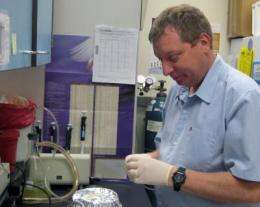Researchers review muscular dystrophy therapies

Leading muscular dystrophy researcher Dean Burkin, of the University of Nevada School of Medicine summarizes the impact of a new protein therapeutic, MG53, for the treatment of Duchenne muscular dystrophy in an article published this week in Science Translational Medicine.
"This is a focus article in which we summarize the impact of MG53 protein therapy as a treatment option and discuss the increasing number of new protein therapeutics being developed for the muscular dystrophies, including laminin-111 developed in our laboratory," Burkin, a pharmacological researcher and associate professor, said.
The article, "A Molecular Bandage for Diseased Muscle," co-authored by Ryan Wuebbles, a post-doctoral student in Burkin's lab in the University's Center for Molecular Medicine, is a review of the current status of therapeutic developments in the muscular dystrophy research field. These therapies represent significant strides and show great promise in treatment of muscular dystrophy.
Approaches to treat Duchenne muscular dystrophy include gene replacement therapy, gene repair and myoblast cell transfer.
In a study on MG53 by Noah Weislander and colleagues, presented in the same issue of Science Translational Medicine, it was found that mice that lack MG53 developed progressive muscle weakness and exhibit defective muscle repair after exercise or injury, and that MG53 facilitates rapid membrane repair to prevent damage to normal muscle.
The study suggests that treatment in combination with other protein therapies such as Burkin's laminin-111 therapy, are likely to have synergy as well for Duchenne and other muscular dystrophies.
Burkin's published research on laminin-111, a naturally occurring protein, showed it is quickly picked up in the bloodstream of mice and prevents muscle damage, an important finding for Duchenne muscular dystrophy, the most common form of muscular dystrophy.
He recently co-hosted Myomatrix 2012, a conference for leading muscular dystrophy scientists and clinicians to explore and share their latest findings and data on treatment breakthroughs. The conference was held at the University of Nevada, Reno campus, where research by Burkin has led to a potential new therapy for muscular dystrophy.
More information: The article by Burkin and Wuebbles can be found at stm.sciencemag.org/content/4/139/139fs19.full
Burkin's work, which is funded by the National Institutes of Health, has also been featured on the website ScienCentral (www.sciencentral.com/video/2009/04/20/muscular-dystrophy-drug/). His work was published in the Proceedings of the National Academy of Sciences as well as the January 2009 edition of American Journal of Pathology.















